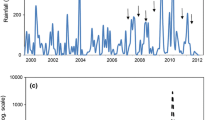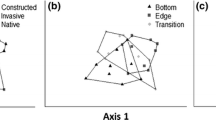Abstract
Soil seed banks are an important component of plant community diversity in ephemeral wetlands, allowing many species to persist through unpredictable periods of flood and drought. Spatial variation of extant vegetation in such habitats commonly reflects patterns of flood history and often varies predictably between broadly differing hydro-geomorphic habitat types. Here we investigate whether spatial variation of soil seed banks is similarly controlled by fluvial processes at this scale. Results are presented from a seedling emergence trial using samples collected from a range of habitat types, and at different scales within these, in the ephemeral Narran Lakes system in semi-arid Australia. Composition and structure of soil seed banks varied significantly between habitat types reflecting broad differences in flood frequency. As predicted, germinable seed abundance was found to be highest in intermediately flooded habitats. Variability in soil seed bank composition at a local scale was also found to be influenced by hydrology with greater spatial heterogeneity evident in the river channel as well as amongst the least frequently inundated riparian and floodplain habitats.







Similar content being viewed by others
References
Baskin CC, Baskin JM (1998) Seeds: ecology, biogeography and evolution of dormancy and germination. Academic Press, San Diego
Belbin L. 1995. PATN. CSIRO Division of Wildlife and Ecology, Canberra
Blom CWPM, Voesnek LACJ (1996) Flooding: the survival strategies of plants. Trends Ecol Evol 11:290–295
Bonis A, Lepart J, Grillas P (1995) Seed bank dynamics and coexistence of annual macrophytes in a temporary and variable habitat. Oikos 74:81–92
Brock MA (1998) Are temporary wetlands resilient? Evidence from seed banks of Australian and South African wetlands. In: McComb AJ, Davis JA (eds), Wetlands for the future: contributions from INTECOL’s V International Wetland Conference. Gleneagles Publishing, Adelaide, pp 193–206
Brock MA, Nielsen DL, Shiel RJ, Green JD, Langley JD (2003) Drought and aquatic community resilience: the role of eggs and seeds in sediments of temporary wetlands. Freshwater Biol 48:1207–1218
Brock MA, Rogers KH (1998) The regeneration potential of the seed bank of an ephemeral floodplain in South Africa. Aquat Bot 61:123–135
Brock MA, Theodore K, O’Donnell L (1994) Seed-bank methods for Australian wetlands. Aust J Marine Freshwater Res 45:483–493
Capon SJ (2003) Plant community responses to wetting and drying in a large arid floodplain. River Res Appl 19:509–520
Capon SJ (2005) Flood variability and spatial variation in plant community composition and structure on a large arid floodplain. J Arid Environ 60:283- 302
Capon SJ, Brock MA (2006) Flood variability, soil seed bank dynamics and vegetation resilience in a desert floodplain. Freshwater Biol 51:206–223
Carr MR (1996) PRIMER (Plymouth routines in multivariate ecological research). Plymouth Marine Laboratory, Plymouth, UK
Casanova MT, Brock MA (2000) How do depth, duration and frequency of flooding influence the establishment of wetland plant communities? Plant Ecol 147:237–250
Gentilli J (1986) Climate. In: Jeans DN (eds), The natural environment - Australia a geography. Sydney University Press, Sydney, pp 14–48
Haukos DA, Smith LA (1993) Seedbank composition and predictive ability of field vegetation in playa lakes. Wetlands 13:32–40
Haukos DA, Smith LA (1994) Composition of seed banks along an elevation gradient in playa wetlands. Wetlands 14:301–307
Higgins SI, Rogers KH, Kemper J (1997) A description of the functional vegetation pattern of a semi-arid floodplain, South Africa. Plant Ecol 129:95–101
Hughes JW, Cass WB (1997) Pattern and process of a floodplain forest, Vermont, USA: predicted responses of vegetation to perturbation. J Appl Ecol 34:594–612
Hupp CR, Osterkamp WR (1996) Riparian vegetation and fluvial geomorphic processes. Geomorphology 14: 277–295
Jensen K, Gutekunst K (2003) Effects of litter on establishment of grassland plant species: the role of seed size and successional status. Basic Appl Ecol 4:579–587
Junk WJ, Bayley PB, Sparks RE (1989) The flood pulse concept in river-floodplain systems. Can Special Publ Fish Aquat Sci 106:110–127
LaDeau SL, Ellison AM (1999) Seed bank composition of a north-eastern U.S. tussock swamp. Wetlands 19:255–261
Leck MA (1989) Wetland seed banks. In: Leck MA, Parker VT, Simpson RL (eds) Ecology of soil seed banks. Academic Press, California
McGraw JB (1987) Seed bank properties of an Appalachian sphagnum bog and a model of the depth distribution of viable seeds. Can J Bot 65:2028–2035
Moro JF, Pugnaire FI, Haase P, Puigdefabregas J (1997) Mechanisms of interaction between Retama sphaerocarpa and its understorey layer in a semi-arid environment. Ecography 20:175–184
Mull JF, MacMahon JA (1996) Factors determining the spatial variability of seed densities in a shrub-steppe ecosystem: the role of harvester ants. J Arid Environ 32:181–192
Nicol JM, Ganf GG, Pelton GA (2003) Seed banks of a southern Australian wetland: the influence of water regime on the final floristic composition. Plant Ecol 168:191–205
Nilsson C, Gardfjell M, Grelsson G (1991) Importance of hydrochory in structuring plant communities along rivers. Can J Bot 69:2631–2633
Nilsson C, Andersson E, Merritt DM, Johansson M (2002) Differences in riparian flora between riverbanks and river lakeshores explained by dispersal traits. Ecology 83:2878–2887
Parker VT, Leck MA (1985) Relationships of seed banks to plant distribution patterns in a freshwater tidal wetland. Am J Bot 72:161–174
Pugnaire FI, Haase P, Puigdefabregas J (1996) Facilitation between higher plant species in a semiarid environment. Ecology 77:1420–1426
Pugnaire FI, Lazaro R (2000) Seed bank and understorey species composition in a semi-arid environment: the effects of shrub age and rainfall. Annal Bot 86:807–813
Rossell IM, Wells CL (1999) The seed banks of a southern Appalachian fen and an adjacent degraded wetland. Wetlands 19:365–371
Southwood TRE, Henderson PA (2000) Ecological methods. Blackwell Science Publishers, Oxford
Stern H, de Haedt G, Ernst J (2000) Objective classification of Australian climates. Aust Meteorol Mag 49:87–96
Stromberg JC (2001) Restoration of riparian vegetation in the south-western United States: importance of flow regimes and fluvial dynamism. J Arid Environ 49:17–34
Thoms MC, Parsons ME (2003) Identifying spatial and temporal patterns in the character of the Condamine–Balonne River, Australia, using multivariate statistics. River Res Appl 19:443–458
Thoms MC, Sheldon F (2002) An ecosystem approach for determining environmental water allocations in Australian dryland river systems: the role of geomorphology. Geomorphology 47:153–168
Thomspon K, Grime JP (1979) Seasonal variation in the seed banks of herbaceous species in ten contrasting habitats. J Ecol 67:893–921
van der Valk AG, Davis CB (1978) The role of seed banks in the vegetation dynamics of prairie glacial marshes. Ecology 59:322–225
Walker KF, Sheldon F, Puckridge JT (1995) A perspective on dryland river ecosystems. Regulated Rivers: Res Management 11:85–104
Wetzel PR, van der Valk AG, Toth LA (2001) Restoration of wetland vegetation on the Kissimmee River floodplain: potential role of seed banks. Wetlands 21:189–198
Acknowledgements
This project was a joint collaboration between the Murray-Darling Basin Commission and the eWater. Support was provided by the Narran Lakes Ecosystem Project team and many land holders, including New South Wales National Parks and Wildlife Service, for which we are grateful.
Author information
Authors and Affiliations
Corresponding author
Rights and permissions
About this article
Cite this article
James, C.S., Capon, S.J., White, M.G. et al. Spatial variability of the soil seed bank in a heterogeneous ephemeral wetland system in semi-arid Australia. Plant Ecol 190, 205–217 (2007). https://doi.org/10.1007/s11258-006-9201-9
Received:
Accepted:
Published:
Issue Date:
DOI: https://doi.org/10.1007/s11258-006-9201-9




